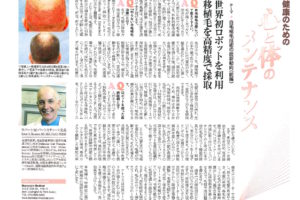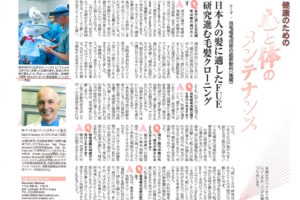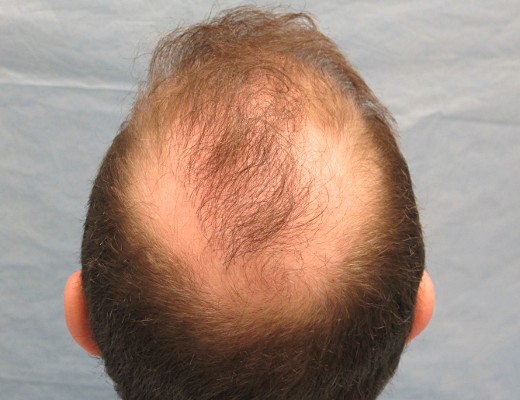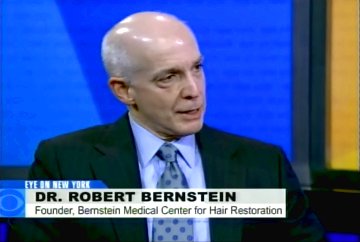Dr. Bernstein was interviewed by Dana Tyler, host of the television program “Eye on New York” on CBS, for the show that aired on April 17th. The wide-ranging interview was the feature in a 9-minute segment on hair transplantation and hair loss.
Below is a partial transcript from the interview.
Hair Loss – Men vs. Women:
DT: How big a problem is it, men versus women? We heard the statistics but is it worse for one group or the other?
RB: It seems to be worse in women emotionally. Statistically it’s obviously more common in men, but the pattern is very different. When men lose their hair they lose it mostly in the front. And they can start in two different patterns. One is in the temples and in the crown or it can just go front to back. That’s called patterned hair loss and it’s pretty obvious. Women have a more diffuse pattern so it would be many years before you even notice it.
DT: What about the influence we hear, if it’s your mother’s father or your mother’s grandfather was bald then therefore, men, you will be. Is there any truth to that?
RB: Like many myths there is a little bit to it. There is a slight predominance coming from the mother’s side of the family. There is something called an androgen receptor gene, that has been found on the X chromosome, which accounts for the slight difference between inheritance from the mother’s side versus the father’s side. But most of the genetics is on the regular chromosomes, called the autosomal chromosomes, which is the same from both sides. So you can get it from either your mother or your father or your uncles or grandparents.
Early Hair Loss:
DT: Age-wise. Are there certain times – I mean, we talked about earlier in the 30s, but some young men it happens earlier.
RB: It seems that when people start to lose their hair early, it has a tendency to be much more severe. So the people who start to thin around 16, 17 usually become very bald. Time is usually on your side if you have hair into your 30s and 40s, [it’s] more likely you’ll have a full head of hair.
Hair Loss in Women:
DT: Speaking about women and the reasons behind women’s hair loss. A little different than for men.
RB: It’s genetic, as with men for the most part, but there are two different systems. Where in men it’s related to androgens directly, which causes the front-to-back pattern, in women they have another enzyme pathway which kind of evens it out and keeps their hairline longer. Also, because women have a tendency to thin all over, their genetic hair loss can be mimicked by other things, such as diseases that cause hair shedding or thinning — so anemia, thyroid disease, medications such as birth control pills — all those things can also contribute to hair loss, and it seems that those factors are much more common in women than in men.
DT: And then in trying to determine if a woman is going through that, because there are more factors is it hard to figure out why there is the hair loss?
RB: It’s a little bit more difficult [in women]. The main thing that you do is to look at the hair diameters. In genetic hair loss the hairs have different diameters. In [conditions] like anemia, or where there is shedding on medication, the hair comes out at its root. Where people think of hair loss as losing hair, most of hair loss is thinning because the hairs are actually thinner in diameter.
Preventing Hair Loss:
DT: Preventing baldness… is there anything that can be done?
RB: There are… But it’s not what you think. It’s not hats and combs.
DT: Fertilizing your head. (laughs)
RB: There are two medications, main medicines. One is Propecia, or the generic term is called finasteride, and what that does is it blocks DHT. And DHT is what causes these hair follicles to gradually miniaturize, or get smaller, and disappear. And the other is Rogaine, which actually stimulates hair follicles directly. Unfortunately, Propecia can’t be used in women because it can cause birth defects during child bearing years and it can also stimulate breast tissue, but it is very effective in men.
DT: So what does a woman do?
RB: Well, Rogaine will help a little bit. Lasers can help a little bit, perhaps not as much as the initial studies have suggested. And then, once you’ve lost your hair, surgical options are available.
Hair Transplantation:
DT: Hair transplants. I know that’s a complicated procedure. And Dr. Max [Gomez] was talking about the art of it, too, when you’re finding someone. Tell me a little bit more…
RB: The main thing in hair transplants is really to determine who is a good candidate. And the interesting thing is that because of the pattern of [hair loss] in men, men usually have a very permanent area on the back and sides of the scalp. So when you move that to the front and top, it will continue to grow. Because women’s hair loss is more diffuse, the back and sides are not always stable. So, when you’re trying to decide if a woman is a good candidate, you have to make sure that the hair, where you get it from, is going to last their lifetime. And only a small percentage of women are really good candidates for that transplant.
The Future of Hair Restoration – Medications & Cloning:
DT: What about the future? Are you optimistic about new options on the horizon?
RB: First of all, new medications are coming out. Latisse is a medication that can grow eyelashes. And we’ve just started studying it in eyebrow hair, and it seems to grow eyebrows as well. There are studies to see if you can grow hair on the scalp. And it certainly will, it’s just whether it’s practical and how well it works. It probably will be of some benefit.
DT: There always is progress, right?
RB: Right. And then [there are] hair transplants where we can take individual follicles rather than having to take a long thin strip, although that still seems to give you the best volume. And then we’re trying to multiply hair. In other words, the limitation of transplants is always that we don’t have [as much] hair as we’d like. So we’re working on cloning. We’re working on multiplying hair that can actually be plucked from the scalp. So that [the original hair] will regenerate, and you then can get the plucked hair to grow into new hair follicles.
For more interviews with Dr. Bernstein, and other media appearances, visit our Bernstein Medical “In The News” section.
Posted by Robert M. Bernstein M.D. 







 “Dermatologic Clinics” is a quarterly review with comprehensive, state-of-the-art information by experts in the field of dermatology. The industries most highly knowledgeable medical professionals provide current, practical information on the diagnosis and treatment of conditions affecting the skin. Each issue of Dermatologic Clinics focuses on a single topic. The July 2005 issue, entitled “Advanced Cosmetic Surgery”, published an article authored by Robert M. Bernstein M.D, and co-authored by William R. Rassman M.D. entitled “
“Dermatologic Clinics” is a quarterly review with comprehensive, state-of-the-art information by experts in the field of dermatology. The industries most highly knowledgeable medical professionals provide current, practical information on the diagnosis and treatment of conditions affecting the skin. Each issue of Dermatologic Clinics focuses on a single topic. The July 2005 issue, entitled “Advanced Cosmetic Surgery”, published an article authored by Robert M. Bernstein M.D, and co-authored by William R. Rassman M.D. entitled “


